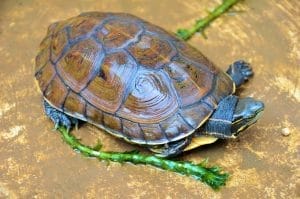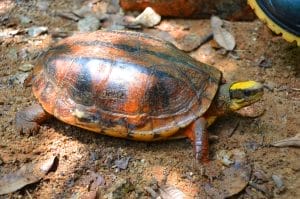Cuora praschagi (Praschag’s Box Turtle)
Home > Turtle Database > Cuora praschagi (Praschag’s Box Turtle)

Cuora praschagi, commonly known as Praschag’s box turtle, is a medium-sized, highly endangered freshwater turtle species found primarily in Southeast Asia. Known for its striking appearance, this species is recognized by conservationists for its critical conservation status due to habitat loss and illegal trade.
Native Turtle Species Map – Find Turtles by Region
Scientific Classification
Kingdom: Animalia
Phylum: Chordata
Class: Reptilia
Order: Testudines
Family: Geoemydidae
Genus: Cuora
Species: Cuora praschagi
Common Names
- Praschag’s Box Turtle
This Hilarious Turtle Book Might Know Your Pet Better Than You Do
Let’s be real—most turtle care guides feel like reading a textbook written by a sleep-deprived zookeeper.
This one’s not that.
Told from the snarky point of view of a grumpy, judgmental turtle, 21 Turtle Truths You’ll Never Read in a Care Guide is packed with sarcasm, sass, and surprisingly useful insights.
And hey—you don’t have to commit to the whole thing just yet.
Grab 2 free truths from the ebook and get a taste of what your turtle really thinks about your setup, your food choices, and that weird plastic palm tree.
It’s funny, it’s honest, and if you’ve ever owned a turtle who glares at you like you’re the problem—you’ll feel seen.
Identification
Description:
Cuora praschagi is a medium-sized turtle with a carapace length of about 18 cm. Its carapace is dark brown to black with three distinctive keels running lengthwise. The plastron is yellow with black blotches, and the head is notably yellow or golden, giving it one of its common names. The limbs are grayish with some yellow markings.
Sexual Dimorphism:
Males typically have a concave plastron, longer tails, and slightly smaller body size compared to females, which have a flatter plastron and shorter tails.
Check more turtles from the Cuora genus
Native Origin and Distribution
Geographical Range:
This species is native to northern Vietnam and possibly parts of southern China, though its exact distribution is poorly understood due to the species’ rarity and the remote locations of its habitats.
Preferred Habitat
Cuora praschagi prefers subtropical forests with dense vegetation, often near small streams or rivers. They are highly aquatic, spending a significant amount of time in water, but they also venture onto land.
Behavior
Feeding Habits:
This omnivorous turtle primarily feeds on aquatic plants, small invertebrates, and occasionally fruits. In captivity, they have been observed to accept a variety of foods, including commercial turtle diets.
Predators:
Due to its small size, Cuora praschagi is vulnerable to predation by larger mammals, birds, and reptiles, particularly when on land.
Reproduction
Breeding Season:
The breeding season typically occurs during the rainy season, from May to August.
Reproductive Method:
Females lay 1-3 eggs per clutch, with the possibility of multiple clutches per year. The eggs are incubated in the warm, moist substrate for approximately 80-100 days before hatching.
Conservation
Extinction Status:
Cuora praschagi is listed as Critically Endangered on the IUCN Red List.
Threats:
The primary threats include habitat destruction due to deforestation, illegal capture for the pet trade, and traditional medicine. The species’ restricted range and specific habitat requirements make it particularly vulnerable.
Conservation Measures:
Conservation efforts include captive breeding programs, habitat protection, and stricter enforcement of wildlife trade regulations. International cooperation is critical to preserving this species.
Economic Importance
Cuora praschagi has limited economic importance, primarily due to its rarity. However, it is sometimes captured illegally for the pet trade, which poses significant conservation challenges.
Interesting Facts
- Cuora praschagi was only formally described in 1995, making it one of the more recently discovered turtle species.
- The species is named after Austrian herpetologist Dr. Peter Praschag, who made significant contributions to turtle conservation.
- Despite its endangered status, Cuora praschagi has become a symbol for conservation efforts in Southeast Asia, highlighting the importance of protecting lesser-known species.

About Author
Muntaseer Rahman started keeping pet turtles back in 2013. He also owns the largest Turtle & Tortoise Facebook community in Bangladesh. These days he is mostly active on Facebook.














